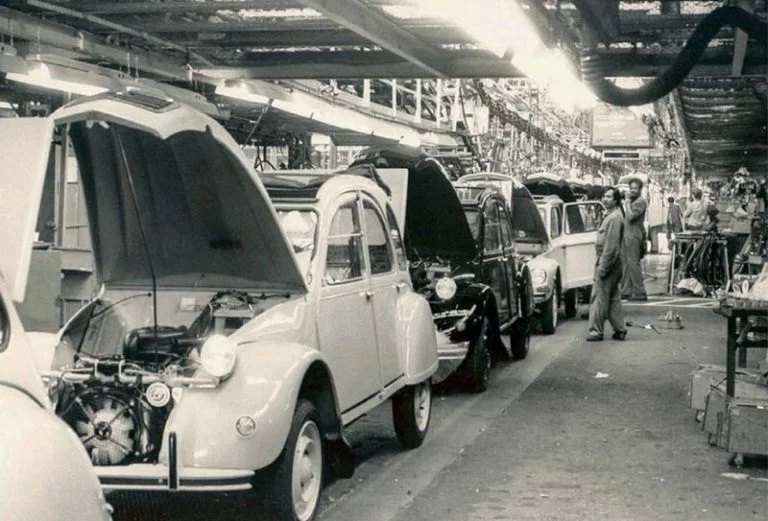
Death: the assembly line, the relentless glide of the cars, the repetition of identical motions, a never-ending task. A car is done? The next isn’t. It is already there, unwelded precisely where one just welded it, raw precisely where one just polished it. Is the welding done? No, to be done. Done for good, this time? No, to be done again, always to be done, never done– as if there were no movement, no effect to movements, nor change, only an absurd simulacrum of labour, immediately undone by some sorcery. And if one were to think none of this matters, that one only needs to get used to repeating the same always identical gestures, always in the same identical timeframe, simply striving for a machine’s quiet perfection? Temptation of death. But life revolts and resists. The body resists. Muscles resist. Nerves resist. Something, in mind and body, pushes back against repetition and oblivion.
Life: a faster movement here, an arm dropped in rest, a slower step there, a breath of irregularity, a false move, moving “up the stream”, moving “down the stream”, a tactical move; all this, this meagre patch of resistance gnawed from the eternal void of the workstation, all this from which there are still events, as insignificant as they are, there is still such a thing as time, even if monstrously stretched. This clumsiness, this unnecessary shifting, this sudden acceleration, this botched weld, this fumbling hand, this grimace, this “stalling”, it is life that hangs on. Everything that, in every man on the assembly line, silently cries out: “I’m not a machine!”
In L’établi (1978), Robert Linhart recounts his experience as a worker on an assembly line in a large Citroën car factory in 1968-1969. Like many other French Maoists, he was part of the movement of the “établis” (established) – intellectuals who had “infiltrated” working-class milieus.
But this is not simply a naive description by a bemused intellectual of something commonplace for a worker. Linhart offers a fascinating and sometimes poetic account of a worker’s life in a very specific context – that of post-Mai 68 France. And what makes L’établi particularly interesting is that Linhart, thanks to his Marxist political education (even if it is the bastardized version that is Maoism), knows how to observe and detail the condition of the working-class with great intelligence and insight.
In particular, his description of assembly-line work (quoted at the beginning of this text) and the alienation it produces in the worker echoes what Marx explains in Capital:
“In handicrafts and manufacture, the workman makes use of a tool, in the factory, the machine makes use of him. There the movements of the instrument of labour proceed from him, here it is the movements of the machine that he must follow. In manufacture the workmen are parts of a living mechanism. In the factory we have a lifeless mechanism independent of the workman, who becomes its mere living appendage.”
Linhart offers a very concrete account of the class struggle under capitalism, which Marx described as the struggle for the division of surplus value. In the factory, the bosses and the workers are constantly in a tug of war to squeeze out a minute here, a minute there: the workers win a victory when they take a break a minute early; the bosses push the employees to the limit, even to the point of injury, to gain a few seconds on the production of a car.
When the Citroën factory management announced that they would take back some of the concessions made to the workers in May 1968 (the famous “Grenelle Agreements”) by extending the working day, Linhart helped organize a strike. His account of the strike is captivating and rich in insights. He explains how the particularities of each trade affect their attitude to the strike, the psychology of the workers and the effect of their individual living conditions, as well as the dynamics of mass psychology.
Linhart penetratingly details the bosses’ ways of breaking the strike, of controlling the workers and keeping them exploited: how they use the poison of racism to keep the workers divided, how they threaten immigrants by using their legal status, how they plot with the yellow union and use mafia-style methods to intimidate and demoralize, and so on.
There would be a lot more to say. L’établi is a dense, rich little book. I can only advise you to read it.

